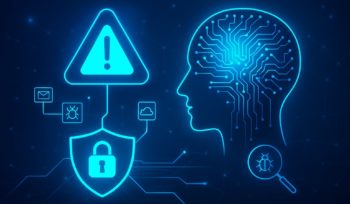How Generative AI Detects Threats Before They Happen
- September 8, 2025
- Posted by: Gradeon
- Category: Cyber Security

In today’s hyper-connected digital world, cyber threats are evolving at an unprecedented pace. Traditional security tools often struggle to keep up with the sheer volume and sophistication of attacks. As a result, businesses are shifting towards proactive cybersecurity strategies, and one technology that’s redefining the game is Generative AI.
Unlike conventional systems that react after a breach has occurred, Generative AI takes a forward-looking approach. It learns from massive datasets, predicts potential vulnerabilities, and identifies abnormal behaviour before threats can materialise. This ability to forecast and neutralise risks ahead of time is what makes Generative AI a powerful ally in modern cybersecurity.
Understanding Generative AI in Cybersecurity
Generative AI refers to AI models that can generate new data, scenarios, and patterns based on what they’ve already learned. In cybersecurity, this capability is leveraged to simulate attack strategies, understand adversarial behaviour, and build predictive models.
Instead of waiting for a cyberattack to occur, Generative AI analyses historical threat data, network behaviour, and user activity to predict future attack patterns. By doing so, it allows security teams to reinforce defences before vulnerabilities are exploited.
For example, if your organisation’s network shows unusual login activity from multiple geographies, Generative AI can flag it as a potential credential compromise even before the attacker executes their plan.
The Shift from Reactive to Proactive Threat Detection
Traditional cybersecurity tools are primarily reactive. They detect anomalies or malware only after an incident is underway, leaving organisations exposed. Generative AI flips this model on its head by anticipating threats:
- It learns continuously from real-time data streams.
- It predicts potential entry points and attack vectors.
- It generates likely scenarios of how an attacker could breach your systems.
This proactive approach means businesses can strengthen weak spots before attackers exploit them. In sectors like banking, healthcare, and e-commerce, where data sensitivity is paramount, this capability is becoming indispensable.
How Generative AI Predicts Cyber Threats
Generative AI doesn’t rely on predefined rules or static signatures. Instead, it adapts dynamically to evolving attack techniques. Here’s how it works:
- Analysing Massive Datasets
Generative AI models process terabytes of security logs, past incident reports, and behavioural data. They identify subtle correlations that human analysts or traditional tools may miss. - Learning from Past Attacks
By simulating thousands of cyberattack scenarios, these models understand patterns of intrusions and exploit tactics. They can spot early signs of similar attacks forming in your environment. - Detecting Anomalous Behaviour
Whether it’s unusual API calls, unexpected data transfers, or suspicious logins, Generative AI identifies anomalies in real time and raises alerts before damage occurs. - Predicting Zero-Day Vulnerabilities
Since Generative AI studies system behaviours rather than known malware signatures, it can anticipate zero-day exploits—attacks that target previously unknown vulnerabilities.
Through these techniques, organisations move from a “detect and respond” mindset to a “predict and prevent” framework.
Applications of Generative AI in Threat Prevention
Generative AI’s predictive capabilities are transforming cybersecurity across industries:
- Phishing Attack Prevention – By analysing billions of email datasets, Generative AI detects subtle patterns in fraudulent communication and blocks phishing attempts before they reach users.
- Ransomware Forecasting – It identifies suspicious file encryption behaviour early, stopping ransomware before it spreads across networks.
- Cloud Security Enhancement – With cloud environments being highly dynamic, Generative AI predicts misconfigurations and detects unusual access attempts instantly.
- IoT Device Protection – From smart homes to connected cars, Generative AI models learn normal device behaviour and raise alerts when abnormal activities occur.
By integrating these insights into security operations, businesses can secure their data, infrastructure, and customers more effectively.
Why Generative AI Is a Game-Changer for Cybersecurity
What sets Generative AI apart from traditional solutions is its self-learning capability. Unlike static tools that require constant updates, Generative AI evolves on its own. It adapts to new attack strategies without relying on manual intervention.
For example, if attackers develop a brand-new malware strain, traditional antivirus tools won’t catch it until it’s been identified and added to a threat database. Generative AI, on the other hand, can flag suspicious behaviour instantly—even if the malware has never been seen before.
This constant evolution allows businesses to stay one step ahead of cybercriminals rather than constantly playing catch-up.
The Human-AI Partnership
While Generative AI provides powerful predictive capabilities, it doesn’t replace human expertise. Security analysts remain crucial in interpreting AI-generated insights and taking appropriate actions.
Generative AI acts as a force multiplier—automating the detection process and giving analysts more time to focus on strategic decisions, incident response, and compliance requirements.
This human-AI collaboration strengthens overall cybersecurity posture and ensures that potential threats are addressed before they escalate.
The Future of Threat Detection
As cyberattacks become more sophisticated, relying solely on reactive defences is no longer sufficient. Generative AI introduces a paradigm shift by enabling predictive threat intelligence.
In the near future, we can expect these systems to integrate seamlessly with Security Information and Event Management (SIEM) platforms and Extended Detection and Response (XDR) tools. This will allow businesses to create fully autonomous security environments where threats are detected and neutralised without manual intervention.
Final Thoughts
Generative AI is transforming cybersecurity by enabling organisations to detect threats before they happen. Its predictive capabilities allow security teams to anticipate attacks, identify vulnerabilities, and protect critical assets proactively.
As businesses face increasingly complex cyber risks, adopting Generative AI-powered security solutions is no longer optional—it’s a necessity. By combining AI-driven insights with human expertise, organisations can build a resilient, adaptive, and future-ready cybersecurity strategy.
